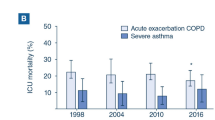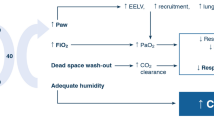Abstract
Objectives
To evaluate the effects of a recombinant strain of Lactococcus lactis secreting bioactive heme oxygenase-1 (LL-HO-1) in a model of hyperoxia-induced lung injury in rat pups
Results
Intranasal administration with LL-HO-1 significantly reduced hyperoxia-induced lung injury as demonstrated by a decreased wet/dry ratio, myeloperoxidase activity in lung tissue, tumor necrosis factor alpha levels in bronchoalveolar lavage (BAL) fluid, and attenuated lung injury scores. Although expression of HO-1 and NADPH oxidase-1 and production of superoxide in lung tissue were not affected by LL-HO-1 treatment, HO-1 levels in nasal mucosa and interleukin-10 concentrations in BAL fluid significantly increased compared with the hyperoxia control group
Conclusions
Intranasal administration of LL-HO-1 protects against hyperoxia-induced lung damage, apparently through attenuation of inflammation.






Similar content being viewed by others
References
Ahmed MN, Suliman HB, Folz RJ, Nozik-Grayck E, GolsonML Mason SN, Auten RL (2003) Extracellular superoxide dismutase protects lung development in hyperoxia-exposed newborn mice. Am J Respir Crit Care Med 167:400–405
Ajuebor MN, Das AM, Virag L, Flower RJ, Szabo C, Perretti M (1999) Role of resident peritoneal macrophages and mast cells in chemokine production and neutrophil migration in acute inflammation: evidence for an inhibitory loop involving endogenous IL-10. J Immunol 162:1685–1691
Bermudez-Humaran LG, Aubry C, Motta JP, Deraison C, Steidler L, Vergnolle N, Chatel JM, Langella P (2013) Engineering lactococci and lactobacilli for human health. Curr Opin Microbiol 16:278–283
Bhandari V, Elias JA (2006) Cytokines in tolerance to hyperoxia-induced injury in the developing and adult lung. Free Radic Biol Med 41:4–18
Carnesecchi S, Deffert C, Pagano A, Garrido-Urbani S, Metrailler-Ruchonnet I, Schappi M, Donati Y, Matthay MA, Krause KH, Barazzone Arqiroffo C (2009) NADPH oxidase-1 plays a crucial role in hyperoxia-induced acute lung injury in mice. Am J Respir Crit Care Med 180:972–981
Chen HI, Yeh DY, Liou HL, Kao SJ (2006) Insulin attenuates endotoxin-induced acute lung injury in conscious rats. Crit Care Med 34:758–764
Donnelly LE, Barnes PJ (2001) Expression of heme oxygenase in human airway epithelial cells. Am J Respir Cell Mol Biol 24:295–303
Frank L (1991) Developmental aspects of experimental pulmonary oxygen-toxicity. Free Rad Biol Med 11:463–494
Griendling KK, Ushio-Fukai M (2000) Reactive oxygen species as mediators of angiotensin II signaling. Regul Pept 91:21–27
Ho YS, Vincent R, Dey MS, Slot JW, Crapo JD (1998) Transgenic models for the study of lung antioxidant defense: enhanced manganese-containing superoxide dismutase activity gives partial protection to B6C3 hybrid mice exposed to hyperoxia. Am J Respir Cell Mol Biol 18:538–547
Jensen JC, Pogrebniak HW, Pass HI, Buresh C, Merino MJ, Kauffman D, Venzon D, Langstein HN, Norton JA (1992) Role of tumor necrosis factor in oxygen toxicity. J Appl Physiol 72:1902–1907
Johnston CJ, Wright TW, Reed CK, Finkelstein JN (1997) Comparison of adult and newborn pulmonary cytokine mRNA expression after hyperoxia. Exp Lung Res 23:537–552
Lambeth JD (2004) NOX enzymes and the biology of reactive oxygen. Nat Rev Immunol 4:181–189
Lee PJ, Alam J, Wiegand GW, Choi AM (1996) Overexpression of heme oxygenase-1 in human pulmonary epithelial cells results in cell growth arrest and increased resistance to hyperoxia. Proc Natl Acad Sci U S A 93:10393–10398
Li J, Gao X, Qian M, Eaton JW (2004) Mitochondrial metabolism underlies hyperoxic cell damage. Free Radic Biol Med 36:1460–1470
Li N, Russell WM, Douglas-Escobar M, Hauser N, Lopez M, Neu J (2009) Live and heat-killed Lactobacillus rhamnosus GG: effects on proinflammatory and anti-inflammatory cytokines/chemokines in gastrostomy-fed infant rats. Pediatr Res 66:203–207
Otterbein LE, Kolls JK, Mantell LL, Cook JL, Alam J, Choi AM (1999) Exogenous administration of heme oxygenase-1 by gene transfer provides protection against hyperoxia-induced lung injury. J Clin Invest 103:1047–1054
Otterbein LE, Bach FH, Alam J, Soares M, Tao LH, Wysk M, Davis RJ, Flavell RA, Choi AM (2000) Carbon monoxide has anti-inflammatory effects involving the mitogen-activated protein kinase pathway. Nat Med 6:422–428
Otterbein LE, Otterbein SL, Ifedigbo E, Liu F, Morse DE, Fearns C, Ulevitch RJ, Knickelbein R, Flavell RA, Choi AM (2003) MKK3 mitogen-activated protein kinase pathway mediates carbon monoxide-induced protection against oxidant-induced lung injury. Am J Pathol 163:2555–2563
Pae HO, Oh GS, Choi BM, Chae SC, Kim YM, Chung KR, Chung HT (2004) Carbon monoxide produced by heme oxygenase-1 suppresses T cell proliferation via inhibition of IL-2 production. J Immunol 172:4744–4751
Pang QF, Ji Y, Li Y, Bermudez-Humaran LG, Hu G, Zeng YM (2008) Intragastric administration with recombinant Lactococcus lactis producing heme oxygenase-1 prevents lipopolysaccharide-induced endotoxemia in rats. FEMS Microbiol Lett 283:62–68
Pang QF, Ji Y, Bermudez-Humaran LG, Zhou QM, Hu G, Zeng YM (2009) Protective effects of a Heme Oxygenase-1-Secreting Lactococcus lactis on mucosal injury induced by hemorrhagic shock in rats. J Surg Res 153:39–45
Shasby DM, Fox RB, Harada RN, Repine JE (1982) Reduction of the edema of acute hyperoxic lung injury by granulocyte depletion. J Appl Physiol 52:1237–1244
Shea LM, Beehler C, Schwartz M, Shenkar R, Tuder R, Abraham E (1996) Hyperoxia activates NF-kappaB and increases TNF-alpha and IFN-gamma gene expression in mouse pulmonary lymphocytes. J Immunol 157:3902–3908
Sorescu D, Weiss D, Lassegue B, Clempus RE, Szocs K, Sorescu GP, Valppu L, Quinn MT, Lambeth JD, Vega JD, TaylorWR Griendling KK (2002) Superoxide production and expression of nox family proteins in human atherosclerosis. Circulation 105:1429–1435
Taylor JL, Carraway MS, Piantadosi CA (1998) Lung-specific induction of heme oxygenase-1 and hyperoxic lung injury. Am J Physiol 274:L582–L590
Van Marter LJ (2009) Epidemiology of bronchopulmonary dysplasia. Semin Fetal Neonatal Med 14:358–366
Wu CY, Zeng YM, Pang QF (2006) Cloning and expression of rat heme oxygenase-1 gene in Lactococcus lactis. Chin J Appl Environ Biol 12:48–51
Yusa T, Crapo JD, Freeman BA (1984) Hyperoxia enhances lung and liver nuclear superoxide generation. Biochim Biophys Acta 798:167–174
Acknowledgments
This research was supported by the National Natural Science Foundation of China (No. 30801075).
Conflict of interest
The authors declare that they have no conflicts of interest.
Author information
Authors and Affiliations
Corresponding author
Rights and permissions
About this article
Cite this article
Wu, CY., Bermúdez-Humarán, L.G., Yue, F. et al. Intranasal administration with recombinant Lactococcus lactis expressing heme oxygenase-1 reduces hyperoxia-induced lung inflammation in rat pups. Biotechnol Lett 37, 1203–1211 (2015). https://doi.org/10.1007/s10529-015-1795-3
Received:
Accepted:
Published:
Issue Date:
DOI: https://doi.org/10.1007/s10529-015-1795-3




